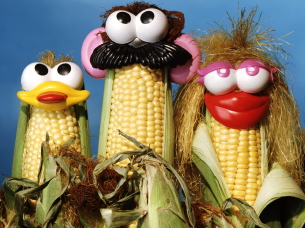
reference-image, l
(article, Curt Ellis)
When we started the King Corn Challenge two and half weeks ago, the idea of living corn-free for a month seemed fun. We’d lay off the soda and the corn-fed burgers, and learn to recognize the ways we unknowingly enjoy America’s biggest crop. We were in for a sobering surprise. Since announcing the contest, we’ve been deluged with a flood of comments, notes, and emails from people who live the King Corn Challenge every day, because they — or someone they love — are allergic to corn. The lists of potential corn products the allergy community has shared with us are unbelievable . . . and ever-expanding: list(compact). Pure vanilla extract (suspended in alcohol derived from corn) Fish (washed with corn-derived citric acid) Dental floss (waxed with corn) Fresh vegetables (coated with corn-based wax) Frozen vegetables (dusted with corn starch) Toilet paper (commonly contains corn derivatives) [%image reference-image float=left width=400 caption="Not everyone is made of corn."] Few of these products are labeled as containing corn, and for someone with a corn allergy, contact with them can lead to hives, migraines, intestinal distress, anaphylactic shock, or wild swings in behavior and mood. Avoiding corn altogether seems to be the only way to stay healthy. Our feeble attempt (mine and Ian's) to get corn out of our diets hasn’t had us baking our own bread from wild yeasts (the store-bought stuff often feeds on ethanol), building our own beehives (commercial keepers often feed their colonies corn syrup in the winter), or calling sausage companies to ask what brand of salt the kielbasa casings were stored with (the iodide is often stabilized with a corn derivative). In truth, we’re only beginning to get corn out of our diets, and come December, we get to go back to eating it. Thank goodness, too; corn isn’t bad or necessarily bad for us, but it’s the basis of cheap food, and it sure seems to be everywhere. My most humbling conversation came yesterday, when I talked with a woman whose six-year-old son started showing signs of a corn allergy when he was a toddler. He would act out when eating baby fruit chews (sweetened with high fructose corn syrup), and refused to color with crayons, play with paste, or touch his hands to finger paint (all include corn derivatives). Then his behavior problems started to approach the bipolar or autistic. Finally, an allergy test exposed the likely culprit. “We cleared our cupboards of corn, and he started to do much better,” his mom told me. “Here was this brilliant child, being suffocated from this allergy.” Since the diagnosis, the boy hasn’t been inside a restaurant, and hasn’t eaten many things Mom didn’t make. But still the allergen has proven almost impossible to avoid: in one incident, Dad passed some nice clean grapes to the little guy after touching his hands to corn-starch and corn-oil coated French fries, and set off a nine-hour reaction. “It’s like being Amish — with electricity,” says Mom. "I bake my own bread, grind my own beef, make my own ketchup and mustard.” Faced with the prospect of raising their boy in a bubble, this remarkable family has decided just to make the bubble big enough for all of them. The sacrifices cut deep: Mom can’t work, and is spending most of this weekend cooking homemade meals for a three-day road trip to an allergy clinic in Baltimore. Thanksgiving may be spaghetti. But in a world without fast food, processed snacks, or restaurant meals, they’re eating well. “We’re unbelievably healthy,” Mom reports. “We grow a big garden, and my six-year-old even has his own plot; he grows beans and lettuce.” And best of all, he can eat them.

reference-image, l

promo-image, l